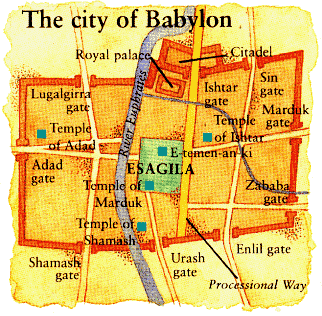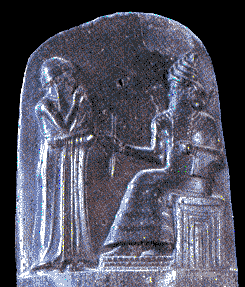Ancient Babylonia - History of Babylonia


The once great city of Babylon, where the Jews were held captive for 70 years, became a symbol of power, materialism, and cruelty.
 The city of Babylon was the capital of the ancient land of Babylonia in
southern Mesopotamia. It was situated on the Euphrates River about 50 miles south of
modern Baghdad, just north of what is now the modern Iraqi town of al-Hillah.
The city of Babylon was the capital of the ancient land of Babylonia in
southern Mesopotamia. It was situated on the Euphrates River about 50 miles south of
modern Baghdad, just north of what is now the modern Iraqi town of al-Hillah.
The tremendous wealth and power of this city, along with its monumental size and appearance, were certainly considered a Biblical myth, that is, until its foundations were unearthed and its riches substantiated during the 19th century. Archaeologists stood in awe as their discoveries revealed that certain stories in the Bible were an actual situation that had happened in time.
A quick overview of the writings of the prophet Isaiah in the Bible, especially chapter 13, reveals some predictions concerning Babylon that stagger the imagination.
The Word "Babylon"
The Location of Babylon Babylon lies in the land of Shinar as revealed in the Bible (Gen 10:10) and its general location has never been disputed. See Geography
The Tower of Babel
 The Bible reveals that all false systems of religion began in the land of
Babylon and will have their consummation from the spirit of Babylon in the last
days. It is interesting to note that every organized system of religion in the
world today has traces of ancient Babylon. The Bible records in Genesis 10:10,
that, after the great flood, all men spoke one common language and a man named
Nimrod built a city and established a common religion. Nimrod was a descendant of
Noah�s son, Ham. Genesis 11:1-9 describes the building of the city and its famous
tower "whose top may reach unto heaven." It also records how God came down and punished the people�s arrogance by creating a confusion of different languages and possibly their
racial distinctions. This way man would be forced to obey God�s original command to "be fruitful and fill the whole earth." It is
interesting that the materials used to build the Tower of Babel were the same as those
employed for the construction of the great ziggurat of Babylon and similar
ziggurats, according to ancient building inscriptions.
The Bible reveals that all false systems of religion began in the land of
Babylon and will have their consummation from the spirit of Babylon in the last
days. It is interesting to note that every organized system of religion in the
world today has traces of ancient Babylon. The Bible records in Genesis 10:10,
that, after the great flood, all men spoke one common language and a man named
Nimrod built a city and established a common religion. Nimrod was a descendant of
Noah�s son, Ham. Genesis 11:1-9 describes the building of the city and its famous
tower "whose top may reach unto heaven." It also records how God came down and punished the people�s arrogance by creating a confusion of different languages and possibly their
racial distinctions. This way man would be forced to obey God�s original command to "be fruitful and fill the whole earth." It is
interesting that the materials used to build the Tower of Babel were the same as those
employed for the construction of the great ziggurat of Babylon and similar
ziggurats, according to ancient building inscriptions.
The Early Growth of Babylon There is evidence that man has lived in this area of Mesopotamia since the beginning of civilization. The first records indicate that Babylon was established as a city around the 23rd century BC. Before this it was a provincial capital ruled by the kings of the city of Ur. Then came the migration of the Amorites.
Quick Overview of Babylonian History Babylonia (pronounced babilahnia) was an ancient empire that existed in the Near East in southern Mesopotamia between the Tigris and the Euphrates Rivers. Throughout much of their history their main rival for supremacy were their neighbors, the Assyrians. It was the Babylonians, under King Nebuchadnezzar II, who destroyed Jerusalem, the capital of the Kingdom of Judah, and carried God�s covenant people into captivity in 587 BC.
The Bible reveals much about the Babylonians all the way back from the time of Hammurapi (2000 BC) to the fall of Babylon (about 500 BC). Throughout the Old Testament there are references to the Babylonians, their people, culture, religion, military power, etc.
Babylonia was a long, narrow country about 40 miles wide at its widest point and having an area of about 8,000 square miles. It was bordered on the north by Assyria, on the east by Elam, on the south and west by the Arabian desert, and on the southeast by the Persian Gulf.
The earliest known inhabitants of Mesopotamia were the Sumerians, whom the Bible refers to as the people of the "land of Shinar" (Gen 10:10). Sargon, from one of the Sumerian cities, united the people of Babylonia under his rule about 2300 B.C. Many scholars believe that Sargon might have been the same person as Nimrod (Gen 10:8).

Artists Depiction of the Ziggurat at Ur
Around 2000 BC Hammurapi emerged as the ruler of Babylonia. He expanded the borders of the Empire and organized its laws into a written system, also known as the Code of Hammurapi. About this time Abraham left Ur, an ancient city located in lower Babylon, and moved to Haran, a city in the north. Later, Abraham left Haran and migrated into the land of Canaan under God's promise that he would become the father of a great nation (Gen 12).
Alongside of Babylonia there must also be a mention of Assyria, which bordered Babylonia on the north. Assyria's development was often intertwined with the course of Babylonian history. About 1270 BC, the Assyrians overpowered Babylonia. For the next 700 years, Babylonia was a lesser power as the Assyrians dominated the ancient world.
Around 626 BC, Babylonian independence was finally won from Assyria by a leader named Nabopolassar. Under his leadership, Babylonia again became the dominant imperial power in the Near East and thus entered into her "golden age." In 605 BC, Nebuchadnezzar II, the son of Nabopolassar, became ruler and reigned for 44 years. Under him the Babylonian Empire reached its greatest strength. Using the treasures which he took from other nations, Nebuchadnezzar built Babylon, the capital city of Babylonia, into one of the leading cities of the world. The famous hanging gardens of Babylon were known to the Greeks as one of the seven wonders of the world.
 As previously mentioned, in 587 BC, the Babylonians destroyed Jerusalem and
carried the leading citizens of the Kingdom of Judah as prisoners to Babylon. The
Hebrew prophet Jeremiah had foretold that the Jews would be free to return
home to Jerusalem after 70 years. The Lord had encouraged His people through
Ezekiel and Daniel who were also captives in Babylon. During this 70 year period of
captivity, the Persians conquered Babylonia, and the Babylonians passed from
the scene as a world power.
As previously mentioned, in 587 BC, the Babylonians destroyed Jerusalem and
carried the leading citizens of the Kingdom of Judah as prisoners to Babylon. The
Hebrew prophet Jeremiah had foretold that the Jews would be free to return
home to Jerusalem after 70 years. The Lord had encouraged His people through
Ezekiel and Daniel who were also captives in Babylon. During this 70 year period of
captivity, the Persians conquered Babylonia, and the Babylonians passed from
the scene as a world power.
Throughout the long period of Babylonia history, the Babylonians achieved a high level of civilization that made an impact on the whole known world. Sumerian culture was its basis, which later Babylonians regarded as traditional. In the area of religion, the Sumerians already had a system of gods, each with a main temple in each city. The chief gods were Anu, god of heaven; Enlil, god of the air; and Enki or Ea, god of the sea. Others were Shamash, the sungod; Sin, the moon-god; Ishtar, goddess of love and war; and Adad, the storm-god. The Amorites promoted the god Marduk at the city of Babylon, so that he became the chief god of the Babylonian religion, starting around 1100 BC.
Babylonian religion was temple-centered, with elaborate festivals and many different types of priests, especially the exorcist and the diviner, who mainly were trained to drive away evil spirits.
Babylonian literature was mainly dominated by mythology and legends. Among these was a creation myth written to glorify their god Marduk. According to this myth, Marduk created heaven and earth from the corpse of the goddess Tiamat. Another work was the Gilgamesh Epic, a flood story written about 2000 BC. Scientific literature of the Babylonians included treatises on astronomy, mathematics, medicine, chemistry, botany, and nature.
 One of the main aspects of Babylonian culture was a codified system of law.
Hammurapi�s famous code was the successor of earlier collections of laws going back to
about 2050 BC. The Babylonians used art for the national celebration of great
events and glorification of the gods. It was marked by stylized and symbolic
representations, but it expressed realism and spontaneity in the depiction of
animals.
One of the main aspects of Babylonian culture was a codified system of law.
Hammurapi�s famous code was the successor of earlier collections of laws going back to
about 2050 BC. The Babylonians used art for the national celebration of great
events and glorification of the gods. It was marked by stylized and symbolic
representations, but it expressed realism and spontaneity in the depiction of
animals.

The Old Testament contains many references to Babylonia. Gen 10:10 mentions four Babylonian cities, Babel (Babylon), Erech (Uruk), Accad (Agade) and Calneh. These, along with Assyria, were ruled by Nimrod.
The History of Babylonia Traditionally the history of Babylonia has been broken down into three major periods:
The Old Babylonian Period (2000-1595 BC)
The Middle Babylonian Period (1595-1000 BC)
The Neo-Babylonian Period (1000-539 BC)
Read The Bible
- 1599 Geneva Bible (GNV)
- 21st Century King James Version (KJ21)
- American Standard Version (ASV)
- Amplified Bible (AMP)
- Amplified Bible, Classic Edition (AMPC)
- Authorized (King James) Version (AKJV)
- BRG Bible (BRG)
- Christian Standard Bible (CSB)
- Common English Bible (CEB)
- Complete Jewish Bible (CJB)
- Contemporary English Version (CEV)
- Darby Translation (DARBY)
- Disciples’ Literal New Testament (DLNT)
- Douay-Rheims 1899 American Edition (DRA)
- Easy-to-Read Version (ERV)
- English Standard Version (ESV)
- English Standard Version Anglicised (ESVUK)
- Evangelical Heritage Version (EHV)
- Expanded Bible (EXB)
- GOD’S WORD Translation (GW)
- Good News Translation (GNT)
- Holman Christian Standard Bible (HCSB)
- International Children’s Bible (ICB)
- International Standard Version (ISV)
- J.B. Phillips New Testament (PHILLIPS)
- Jubilee Bible 2000 (JUB)
- King James Version (KJV)
- Lexham English Bible (LEB)
- Living Bible (TLB)
- Modern English Version (MEV)
- Mounce Reverse Interlinear New Testament (MOUNCE)
- Names of God Bible (NOG)
- New American Bible (Revised Edition) (NABRE)
- New American Standard Bible (NASB)
- New American Standard Bible 1995 (NASB1995)
- New Catholic Bible (NCB)
- New Century Version (NCV)
- New English Translation (NET)
- New International Reader's Version (NIRV)
- New International Version - UK (NIVUK)
- New International Version (NIV)
- New King James Version (NKJV)
- New Life Version (NLV)
- New Living Translation (NLT)
- New Matthew Bible (NMB)
- New Revised Standard Version (NRSV)
- New Revised Standard Version Catholic Edition (NRSVCE)
- New Revised Standard Version, Anglicised (NRSVA)
- New Revised Standard Version, Anglicised Catholic Edition (NRSVACE)
- New Testament for Everyone (NTE)
- Orthodox Jewish Bible (OJB)
- Revised Geneva Translation (RGT)
- Revised Standard Version (RSV)
- Revised Standard Version Catholic Edition (RSVCE)
- The Message (MSG)
- The Voice (VOICE)
- Tree of Life Version (TLV)
- World English Bible (WEB)
- Worldwide English (New Testament) (WE)
- Wycliffe Bible (WYC)
- Young's Literal Translation (YLT)
Table of Contents
Main Menu
- Ancient Assyrian Social Structure
- Ancient Babylonia
- Ancient Canaan During the Time of Joshua
- Ancient History Timeline
- Ancient Oil Lamps
- Antonia Fortress
- Archaeology of Ancient Assyria
- Assyria and Bible Prophecy
- Augustus Caesar
- Background Bible Study
- Bible
- Biblical Geography
- Fallen Empires - Archaeological Discoveries and the Bible
- First Century Jerusalem
- Glossary of Latin Words
- Herod Agrippa I
- Herod Antipas
- Herod the Great
- Herod's Temple
- High Priest's in New Testament Times
- Jewish Literature in New Testament Times
- Library collection
- Map of David's Kingdom
- Map of the Divided Kingdom - Israel and Judah
- Map of the Ministry of Jesus
- Matthew Henry Bible Commentary
- Messianic Prophecy
- Nero Caesar Emperor
- Online Bible Maps
- Paul's First Missionary Journey
- Paul's Second Missionary Journey
- Paul's Third Missionary Journey
- Pontius Pilate
- Questions About the Ancient World
- Tabernacle of Ancient Israel
- Tax Collectors in New Testament Times
- The Babylonian Captivity
- The Black Obelisk of Shalmaneser
- The Books of the New Testament
- The Court of the Gentiles
- The Court of the Women in the Temple
- The Destruction of Israel
- The Fall of Judah with Map
- The History Of Rome
- The Incredible Bible
- The Jewish Calendar in Ancient Hebrew History
- The Life of Jesus in Chronological Order
- The Life of Jesus in Harmony
- The Names of God
- The New Testament
- The Old Testament
- The Passion of the Christ
- The Pharisees
- The Sacred Year of Israel in New Testament Times
- The Samaritans
- The Scribes
Ancient Questions
- Why Do the Huldah Gates Appear Different in Ancient Replicas and Modern Photos?
- What Is the Origin of the Japanese and Chinese Peoples? A Biblical Perspective
- How did the ancient Greeks and Romans practice medicine and treat illnesses?
- What were the major contributions of ancient Babylon to mathematics and astronomy?
- How did the ancient Persians create and administer their vast empire?
- What were the cultural and artistic achievements of ancient India, particularly during the Gupta Empire?
- How did ancient civilizations like the Incas and Aztecs build their remarkable cities and structures?
- What were the major trade routes and trading practices of the ancient world?
- What was the role of slavery in ancient societies like Rome and Greece?
- How did the ancient Mayans develop their sophisticated calendar system?
Bible Study Questions
- Why Do Christians Celebrate Christmas?
- How Many Chapters Are There in the Bible?
- The Five Key Visions in the New Testament
- The 400-Year Prophecy: Unpacking Genesis 15 and the Journey of a People
- The Authorized (King James) Version (AKJV): Historical Significance, Translation Methodology, and Lasting Impact
- Exploring the English Standard Version (ESV): Its Aspects, Comparisons, Impact on Biblical Studies, and Church Use
- A Detailed Historical Analysis of Language Updates in the KJ21: Comparison with Other Versions
- A Detailed Historical Analysis of the American Standard Version (ASV): Comparison to the King James Version, Influence on Later Translations, and Evaluation of Strengths and Weaknesses
- A Detailed Historical Analysis of Amplifications in the Amplified Bible (AMP) and Its Comparison to Other Bible Translations
- Detailed Historical Analysis of the Amplified Bible Classic Edition (AMPC): Examples of Amplifications and Comparative Analysis with Other Bible Translations
About
Welcome to Free Bible: Unearthing the Past, Illuminating the Present! Step into a world where ancient history and biblical narratives intertwine, inviting you to explore the rich tapestry of human civilization.
Discover the captivating stories of forgotten empires, delve into the customs and cultures of our ancestors, and witness the remarkable findings unearthed by dedicated archaeologists.
Immerse yourself in a treasure trove of knowledge, where the past comes alive and illuminates our understanding of the present.
Join us on this extraordinary journey through time, where curiosity is rewarded and ancient mysteries await your exploration.
Recent posts
-

Understanding the Different Kinds of Charities and Their Impact
Charities play a vital role in society, offering support, services, and advocacy across a wide range of causes. From protecting vulnerable animals to ... -

Best gemstones for stud earrings for 15 years girl
Selecting the perfect pair of stud earrings for a 15-year-old girl is an exciting yet thoughtful process. Stud earrings are a timeless accessory, offe... -

Prayers for Prophets: A Reflection on Reverence and Intercession
Prophets hold a revered status across many of the world’s major religions. As individuals chosen to convey divine messages, they are often remembere... -

How Machine Learning is Reducing Risk in Automated Trading
In today’s fast-paced monetary markets, automated buying and selling has come to be a cornerstone of current making an investment. Algorithms now ex... -

Timur Turlov: Driving Global Investment Innovation Through Freedom Holding Corp.
Timur Turlov leads Freedom Holding Corp. (NASDAQ: FRHC) as its CEO where he connects technology with finance and global markets. Turlov established Fr...